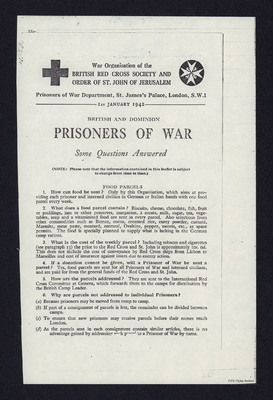Prisoners of war - some questions answered
Title
Prisoners of war - some questions answered
Description
Instructions about sending food parcels. How, food, what could be sent, costs, donations, addressing. Concludes with reasons why parcels not addressed to individual prisoners.
Date
1942-01-01
Temporal Coverage
Spatial Coverage
Coverage
Language
Type
Format
One page printed document
Publisher
Rights
This content is available under a CC BY-NC 4.0 International license (Creative Commons Attribution-NonCommercial 4.0). It has been published ‘as is’ and may contain inaccuracies or culturally inappropriate references that do not necessarily reflect the official policy or position of the University of Lincoln or the International Bomber Command Centre. For more information, visit https://creativecommons.org/licenses/by-nc/4.0/ and https://ibccdigitalarchive.lincoln.ac.uk/omeka/legal.
Contributor
Identifier
SJenkinsonLP1316403v10031
Transcription
War Organisation of the
BRITISH RED CROSS SOCIETY AND ORDER OF ST. JOHN OF JERUSALEM
Prisoners of War Department, St. James’s Palace, London S.W.1
1st JANUARY 1942
BRITISH AND DOMINION PRISONERS OF WAR
Some Questions Answered
(NOTE: Please note that the information contained in this leaflet is subject to change from time to time)
FOOD PARCELS
1. How can food be sent? Only by this Organisation, which aims at providing each prisoner and interned civilian in German or Italian hands with one food parcel every week.
2.'What does a food parcel contain? Biscuits, cheese, chocolate, fish, fruit or puddings, jam or other
preserves, margarine, 2 meats, milk, sugar, rea, vegetables, soap and a vitaminised food are sent in
every parcel. Also selections from other commodities such as Bernax, cocoa, creamed rice, curry
powder, custard, Marmite, meat paste, mustard, oatmeal, Ovaltine, pepper, sweets, etc., as space
permits. The food is specially planned to supply what is lacking in the German camp rations.
3. What is the cost of the 'weekly parcel? Including tobacco and cigarettes (see paragraph 13) the price to the Red Cross and St. John is approximately 10/0d.This does not include the cost of conveyance by Red Cross ships from Lisbon to Marseilles and cost of insurance against losses due to enemy action.
4. If a donation cannot be given, will a Prisoner of War- be sent a parcel? Yes, food parcels are sent for all Prisoners of War and interned civilians, and are paid for from the general funds of the Red Cross and St. John.
5. How are the parcels addressed? They are sent to the International Red Cross Committee at Geneva, which forwards them to the camps for distribution by the British Camp Leader.
6. Why are parcels not addressed to individual Prisoners?
(a) Because prisoners may be moved from camp to camp.
(b) If part of a consignment of parcels is lost, the remainder can be divided between
camps. .
(c) To ensure that new prisoners may receive parcels before their names reach London.
(d) As the parcels sent in each consignment contain similar articles, there is no advantage gained by addressing each parcel to a Prisoner of War by name.
BRITISH RED CROSS SOCIETY AND ORDER OF ST. JOHN OF JERUSALEM
Prisoners of War Department, St. James’s Palace, London S.W.1
1st JANUARY 1942
BRITISH AND DOMINION PRISONERS OF WAR
Some Questions Answered
(NOTE: Please note that the information contained in this leaflet is subject to change from time to time)
FOOD PARCELS
1. How can food be sent? Only by this Organisation, which aims at providing each prisoner and interned civilian in German or Italian hands with one food parcel every week.
2.'What does a food parcel contain? Biscuits, cheese, chocolate, fish, fruit or puddings, jam or other
preserves, margarine, 2 meats, milk, sugar, rea, vegetables, soap and a vitaminised food are sent in
every parcel. Also selections from other commodities such as Bernax, cocoa, creamed rice, curry
powder, custard, Marmite, meat paste, mustard, oatmeal, Ovaltine, pepper, sweets, etc., as space
permits. The food is specially planned to supply what is lacking in the German camp rations.
3. What is the cost of the 'weekly parcel? Including tobacco and cigarettes (see paragraph 13) the price to the Red Cross and St. John is approximately 10/0d.This does not include the cost of conveyance by Red Cross ships from Lisbon to Marseilles and cost of insurance against losses due to enemy action.
4. If a donation cannot be given, will a Prisoner of War- be sent a parcel? Yes, food parcels are sent for all Prisoners of War and interned civilians, and are paid for from the general funds of the Red Cross and St. John.
5. How are the parcels addressed? They are sent to the International Red Cross Committee at Geneva, which forwards them to the camps for distribution by the British Camp Leader.
6. Why are parcels not addressed to individual Prisoners?
(a) Because prisoners may be moved from camp to camp.
(b) If part of a consignment of parcels is lost, the remainder can be divided between
camps. .
(c) To ensure that new prisoners may receive parcels before their names reach London.
(d) As the parcels sent in each consignment contain similar articles, there is no advantage gained by addressing each parcel to a Prisoner of War by name.
Citation
British Red Cross Society and Order of St John of Jerusalem, “Prisoners of war - some questions answered,” IBCC Digital Archive, accessed October 29, 2024, https://ibccdigitalarchive.lincoln.ac.uk/omeka/collections/document/30629.
Item Relations
This item has no relations.

